#FAON-ART
Explore tagged Tumblr posts
Text

Joining the trend of RadioApple fankids. Their names translate to Star and Fawn, and their Initals are AM and FM
Aged up slightly redesigned version here
EDIT: Updated with better art!
Faon is a very quiet well behaved kid when hes on his own, but easily gets swept up and over excited when others (Usually Astre) come up with a plan or game. He likes to join in an be included, but often oversteps boundaries or takes things too far without meaning to. His sense of humour definatly takes more after Alastor than Lucifer, and he doesnt flinch at extreme violence or gore.
Astra is the mastermind of the two. She notices when a situation happens that she can take advantage of to benefit her and her twin. Whether its to get extra dessert, or sneak out after curfew by starting the adults arguing over a misunderstanding.
Despite her age, Astre sees it as her responsibility to protect her family, parents and extended family included. She dislikes strangers and never trusts someone unless they've proven themselves to be safe. She very much looks up to Alastor's method of making everyone too scared to be a threat.
Faon is almost the exact opposite. Despite being shy with new people, he wants to believe that peple don't mean them harm unless they actually do something against the family. He trusts both their dads judgment on who is safe, and tends to stick close to them or Astra when they are out in public. He admires Lucifers cautious attitude towards sinners, but Charlies optimism that some people jsut need some help to be good people.
Astra will dress like Faon deliberatly to confuse people, using the fact they're identical to her advantage. Faon prefers to make it clear which of them is which, immediately correcting people who mistake the two of them.
(Old art under the cut)

#hazbin hotel#hazbin fanart#helluverse#hellaverse#fanart#demon#alastor#hazbin alastor#hazbin art#hazbin lucifer#radioapple#appleradio#lucifer/alastor#fankids#fankid#radioapple fankid#radioapple fanchild#fanchild#hazbin fankid#astre morningstar#faon morningstar#am and pm#star and fawn#their names are french because Alastor speaks french#twins#hazbin twins#duckiedeer#radioappletwins#astre and faon#am and fm
36 notes
·
View notes
Text
Deer of up North
There's lots of deer and I can't keep them straight, so here's a list of all deer species found in the subtemperate regions of the Northern hemisphere: Canada, northern Europe, Siberia. This list does not cover the many other deer species.
General deer facts
Deer are ruminants: even-toed ungulates that chew their cud. Yes, that means all true deer are kosher. They're all herbivorous (which means they'll eat meat only if they don't have to work hard for it). True deer are the family Cervidae, but some other species are called "deer" based on looks.
In almost all species, males grow and shed antlers once a year, and females lack antlers. Males also tend to be much larger than females.
Depending on species and region, a male deer is called a stag, buck, or bull; a female deer a doe, hind, or cow; a young deer a fawn or a calf. In French, the male is called the generic term for deer, un cerf; the female is une biche and the young un faon.
Deer are smaller than you expect, except moose, which are bigger. Most deer species have shoulder heights between 50 cm and 1 m. Deer on this list are on the larger side because they live in cold areas.
Most deer are polygynous, with one mating season (rut) per year. Males fight with their antlers over groups of females. Pregnancy is long, and most species have one fawn at a time.
There are 12 species of deer in the area I'm talking about. 11 are true deer, 1 is an impostor amogus.
Red deer (Cervus elaphus)
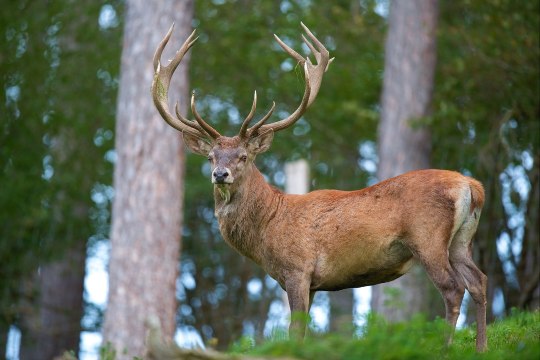
Stag red deer in a forest near Rochefort, Belgium. Photo by Luc Viatour, 2011.
Name in English: Red deer. Name in French: Usually just cerf since it's the default European deer. Cerf élaphe if you're pedantic. Lives in: Europe and Western Asia. Introduced in Australia, New Zealand, and South America. Shoulder height: 1–1.3 m. Red deer are very big as deer go.
This deer is common in Europe, and often hunted and portrayed in art. It's rather social and forms herds. It lives in woods, and migrates to higher altitudes in summer.
Wapiti (Cervus canadensis)
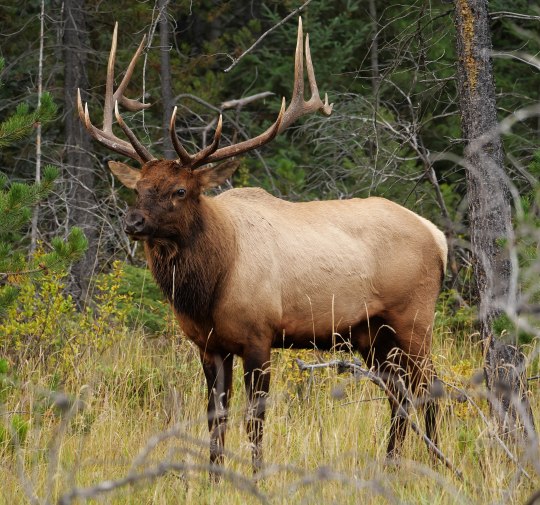
Bull wapiti in Jasper National Park, Alberta, Canada. Photo by Membeth, 2019.
Name in English: In Europe, wapiti. In North America, elk. Ambiguity warning: in Europe, elk usually means moose (Alces alces). Name in French: Exactly the same problem, with the cognate terms. In Europe, wapiti. In North America, élan. Ambiguity warning: in Europe, élan usually means moose (Alces alces). Lives in: North America and East Asia. Introduced to South America and New Zealand. Shoulder height: 0.8–1.5 m. They're even bigger than red deer on average.
The wapiti is closely related to the red deer, and occupies a similar niche. Their native ranges don't overlap, but they often hybridise where both species are introduced.
Sika deer (Cervus nippon)
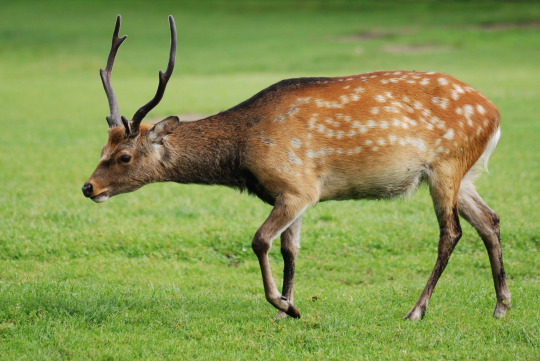
Stag sika deer in Poland. Photo by Lilly M, 2007.
Name in English: Northern spotted deer, Japanese deer, sika deer. Name in French: Cerf sika. Lives in: East Asia, mainly Japan. Introduced to a whole bunch of countries, including Canada, the United States, Russia, and many European countries. Shoulder height: 0.5–1.1 m depending on sex and subspecies.
The sika deer remains spotted as an adult, whereas in most species, only fawns have spots. Its distribution is weird af: its native range is a big chunk of East Asia, but it's died out in most of it, except in Japan where it's breeding like crazy, and it has introduced breeding populations in random places. It's closely related to the red deer and they sometimes hybridise.
Fallow deer (Dama dama)
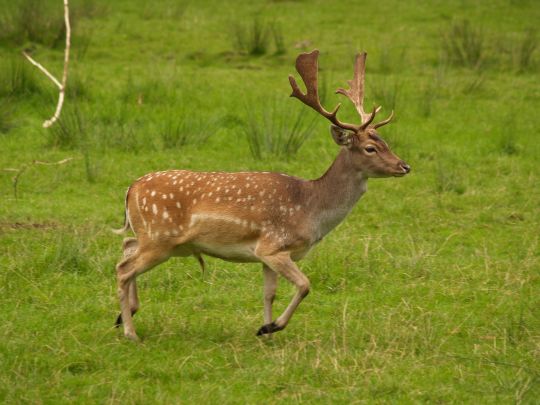
Buck fallow deer in a field in the German state of Schleswig-Holstein. Photo by Johann-Nikolaus Andreae, 2008.
Name in English: Usually simply fallow deer. European or common fallow deer to clarify. Name in French: Daim. To clarify, daim européen. Lives in: Native to Turkey. Introduced in most of Europe, North and South America, parts of Africa, Oceania. Shoulder height: About 85 cm.
Another deer that stays spotted as an adult, though there are many colour variants. It too has a weird distribution. Its antlers have a broad, flat shape.
Reeves's muntjac (Muntiacus reevesi)
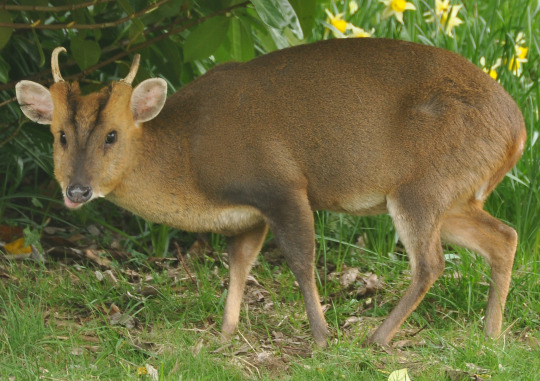
Buck Reeves's muntjac in a garden in England. Photo by Nilfanion, 2010.
Name in English: Reeves's muntjac, Chinese muntjac, barking deer. Sometimes spelt muntjak. Name in French: Lots of different names, none of which are commonly used: muntjac de Reeves, muntjac de Chine, cerf aboyeur, cerf muntjac. Lives in: Native to Taiwan and southeastern China. Introduced in Europe and Japan. Shoulder height: About 50 cm.
There are many species of muntjacs, but only one has established breeding populations far enough north to make this list. All of them are small for deer and breed year-round instead of seasonally.
Bucks of all muntjac species have both tusks and antlers. The tusks are the main weapon; the antlers are short and mostly used to knock opponents out of balance and into tusk range. Fun fact: the ancestor of deer had tusks and no antlers, but true deer lost their tusks, and some lineages re-evolved them.
Roe deer (Capreolus capreolus)
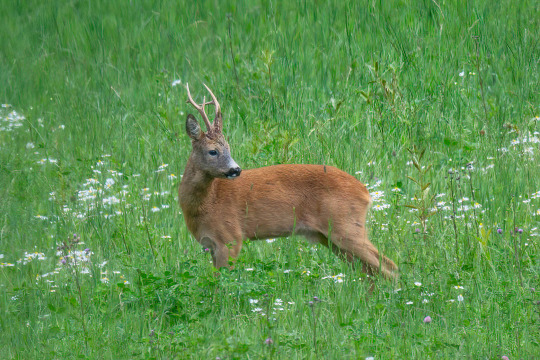
Roebuck in Vaxholm, Sweden. Photo by Bengt Nyman, 2023.
Name in English: Roe or roe deer. If you're pedantic, European or western roe deer. Name in French: Chevreuil. If you're pedantic, chevreuil d'Europe. Ambiguity warning: in Canada, chevreuil can mean the whitetail (Odocoileus virginianus). Lives in: Europe and parts of western Asia. Shoulder height: About 65 cm.
Roe deer use forests for cover, but often venture into open areas to graze. Outside mating season, they're solitary and territorial. The doe usually has two fawns rather than one, typically a male and a female.
Siberian roe deer (Capreolus pygargus)

Siberian roebuck at the Daursky Nature Reserve in Zabaykalsky Krai, Russia. Photo by Andrey Giljov, 2016.
Name in English: Siberian, eastern, or Asian roe deer. Name in French: Chevreuil de Sibérie or chevreuil d'Asie. Lives in: Take a wild guess: Asia, mainly Siberia. Shoulder height: About 85 cm.
This species is extremely similar to the closely related western roe deer, except that it's taller and thinner, and its antlers are longer. It's named pygargus after its white rump, which the western roe deer also has, so idk man.
White-tailed deer (Odocoileus virginianus)
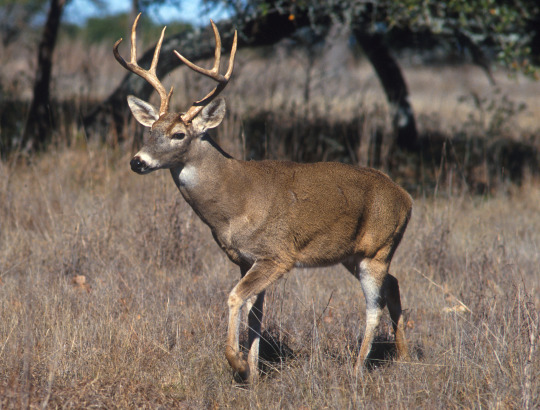
Buck whitetail in the United States. Photo by Scott Bauer, 2001.
Name in English: Whitetail, white-tailed deer, Virginia deer (it's not particularly Virginian but ok). Name in French: If you're being pedantic, cerf de Virginie. In Québec, sometimes chevreuil. Ambiguity warning: in Europe, chevreuil means the roe deer (Capreolus sp.). Lives in: North, Central, and parts of South America. Shoulder height: Varies hugely, 0.5–1.2 m depending on subspecies.
The default North American deer. Bambi from Bambi (1942) is a whitetail.
It mostly lives at the edge of forests, often near humans. When spooked, it raises its tail, showing the white underside. This alerts other deer to danger. Litter size varies, with one, two, or three fawns.
Mule deer (Odocoileus hemionus)

Buck mule deer in the US state of Oregon. Photo from the Oregon Department of Fish & Wildlife, 2010.
Name in English: Mule deer. Some subspecies are called black-tailed deer. Name in French: Not present in any French-speaking areas, but cerf hémione or cerf mulet. Lives in: Western half of North America. Shoulder height: 0.8–1 m
Named for its huge-ass ears. Litter size is usually two fawns, sometimes one. It's not very social and usually solitary, but can also form small groups. Infuriating fact: there's a subspecies called the Sitka deer after the city of Sitka (Alaska, USA), completely unrelated to the sika deer.
Reindeer (Rangifer tarandus)
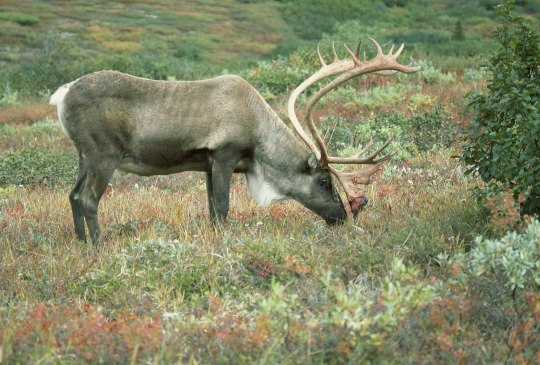
Wild bull reindeer in Alaska. Note the remains of shedding velvet on the tip of one antler. (Or don't note it, I'm not a cop.) Photo by Dave Menke, U.S. Fish and Wildlife Service, 1995.
Name in English: Reindeer or caribou. Reindeer is more common in Europe, caribou in North America. Some people use reindeer for domestic subspecies and caribou for wild ones. Name in French: Renne or caribou, with roughly the same usage patterns. Lives in: Canada, Siberia, extreme north of Europe. Shoulder height: Varies hugely by subspecies, 0.8–1.5 m.
Reindeer live in large herds. Different subspecies migrate very long distances, short distances from mountain in summer to lowlands in winter, or not at all.
They have the biggest antlers of all deer, relative to body size. Females also have antlers, which they use to compete over food during pregnancy. They lose their antlers after calving, later in the year than males.
All societies around the north pole heavily herd or hunt reindeer, and often portray them in art and culture.
Moose (Alces alces)
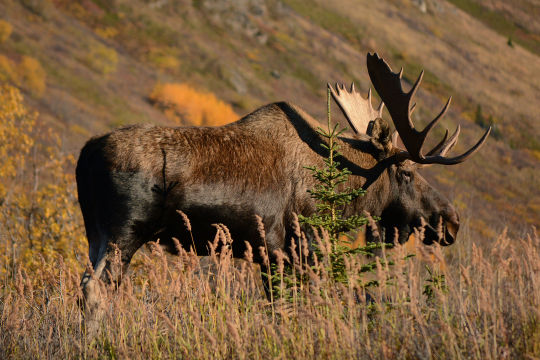
Bull moose in Alaska. Photo by Paxson Woelber, 2014.
Name in English: In Europe, elk. In North America, moose. Ambiguity warning: in North America, elk usually means wapiti (Cervus canadensis). Name in French: Exactly the same problem. In Europe, élan. In North America, orignal (you are contractually obligated to make an orignal/original pun). Ambiguity warning: in North America, élan usually means wapiti (Cervus canadensis). Lives in: All around the north pole: Canada and small parts of the northern US, northern Europe, Siberia. Shoulder height: 1.5–2 m, by far the biggest deer.
Moose are good swimmers and browse for aquatic plants. Their oddly-shaped nose gives them an excellent sense of smell, and their long legs allow them to walk through snow easily. They're mostly solitary outside mating season. They usually have one calf, but twins are very common when food is plentiful.
Siberian musk deer (Moschus moschiferus) (not a deer)
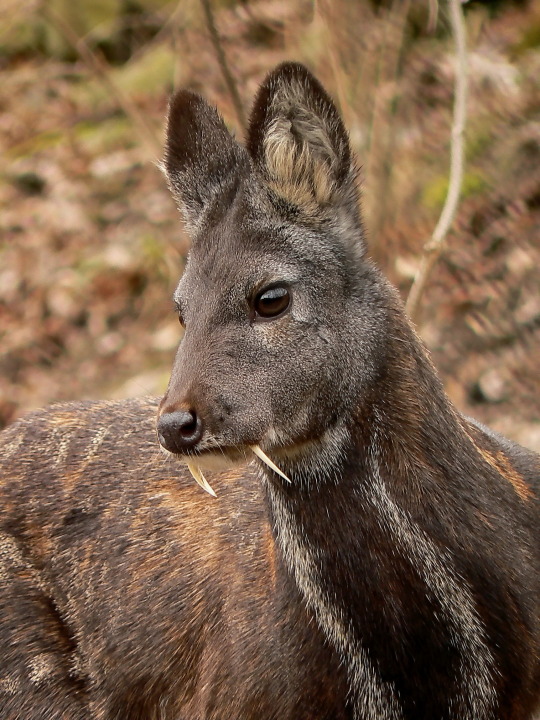
Male Siberian musk deer at a zoo in Plzeň, Czechia. Photo by Николай Усик (Nicolai Usik), 2011.
Name in English: No really common name, just Siberian musk deer. Name in French: No really common name, just porte-musc de Sibérie. Lives in: Far east Asia: Korea, eastern Siberia, Mongolia, northeastern China. Shoulder height: About 50 cm.
Musk deer are not true deer; they're more closely related to cows. There are seven species, living mostly in South Asia. None have antlers or horns, and males of all species have tusks.
Siberian musk deer are solitary and territorial. They live in sloped taiga, are nocturnal, and mainly eat lichen. Females are larger than males, for once. Litter size varies, with one, two, or three young.
Males have a gland in their schlong that makes musk, a scented substance used in perfumes and traditional medicine. They are poached for their musk and musk glands, making the species vulnerable.
Family tree of all the guys above
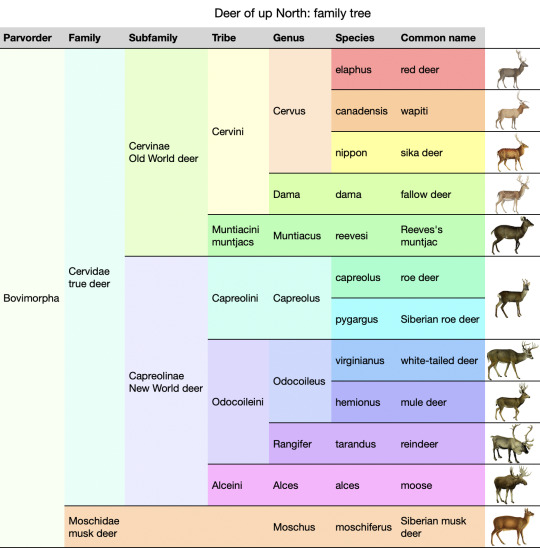
Family tree of these 12 deer. Note that the "Old World" and "New World" names for the two subfamilies are kinda fake and gay: wapiti live in the New World; roe deer live in the Old World but are the poster child of the New World family; reindeer and moose live in both.
Other cool deer include the many deer of the Indian subcontinent, like the sambar (Rusa unicolor), and the small deer of South America, like the pudu (Pudu sp). Other cool non-deer include the tiny adorable mouse-deer (chevrotains, Tragulidae).
#taxonomy#effortpost#deer#Cervidae#Ruminantia#Artiodactyla#ungulate#mammal#Mammalia#this is largely a note to self#long post cw#very long post cw
0 notes
Text
Titre : 🌿 Une Rencontre Enchantée dans la Forêt des Faons 🦌✨

Il était une fois, dans un recoin caché de mon imagination, une forêt enchantée où des faons gambadaient joyeusement sous les arbres aux feuilles scintillantes. Chaque pas dans cette forêt révélait une nouvelle scène de sérénité et de merveille, un tableau vivant de la nature dans son état le plus pur et le plus magique. 🌳🌟
J'ai toujours été fasciné par la façon dont la nature et l'art peuvent se rencontrer et créer quelque chose d'extraordinairement beau et apaisant. C'est dans cet esprit que j'ai commencé à explorer ce monde féerique, à capturer l'essence de chaque rencontre enchantée avec ces créatures délicates et à la transformer en une collection d'images qui racontent une histoire. 🎨💙
Chaque image est un fragment de rêve, un instant de tranquillité capturé pour toujours, une invitation à s'évader et à explorer votre propre forêt intérieure. C'est un rappel de la beauté qui nous entoure, souvent négligée dans le tumulte de notre quotidien. 🍃✨
Alors, je vous invite à vous joindre à moi, à faire une pause, à respirer profondément et à vous perdre dans la contemplation de ces faons enchantés. Laissez leur douceur et leur innocence vous transporter dans un univers où règnent la paix et la sérénité. 🦌🌿
Si vous vous sentez inspiré et souhaitez emporter un morceau de ce monde magique chez vous, je vous invite à explorer plus en détail cette collection unique et à découvrir comment elle a vu le jour. Qui sait, peut-être trouverez-vous votre propre coin de forêt enchantée à chérir et à partager. 💫
#ForêtEnchantée#FaonsBleus#NatureMagique#ArtEtRêve#Sérénité#ExplorationCréative#HistoireEnchantée#ArtNumérique#DécorationMurale#Imprimable#IllustrationNature#FauneEnchantée#HarmonieNature#Créativité#UniversPoétique#InspirationDéco#Evasion#BeautéNaturelle#TableauRêve#CollectionExclusive#EtsyArtiste#DécouverteArtistique#AmbianceFéerique#MerveillesNaturelles#VoyageVisuel#TranquillitéNaturelle#MagieForestière
1 note
·
View note
Photo
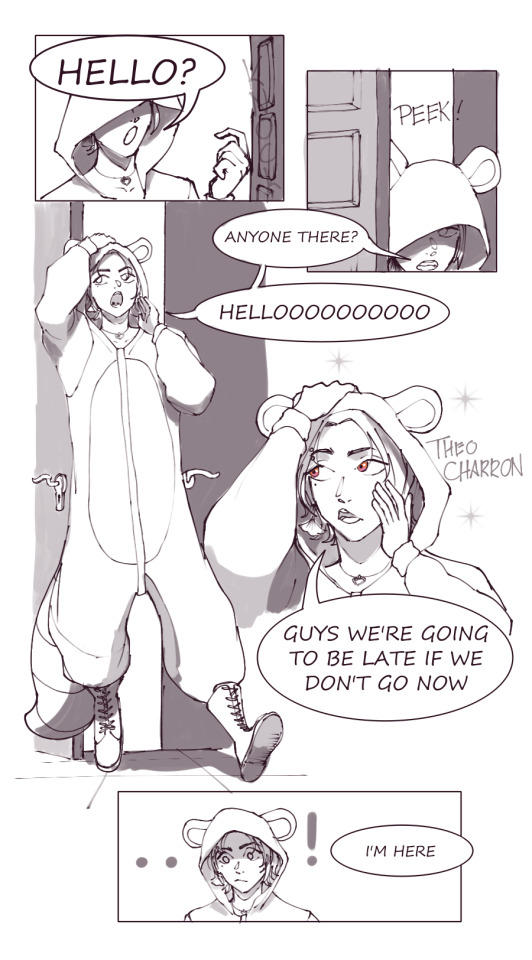
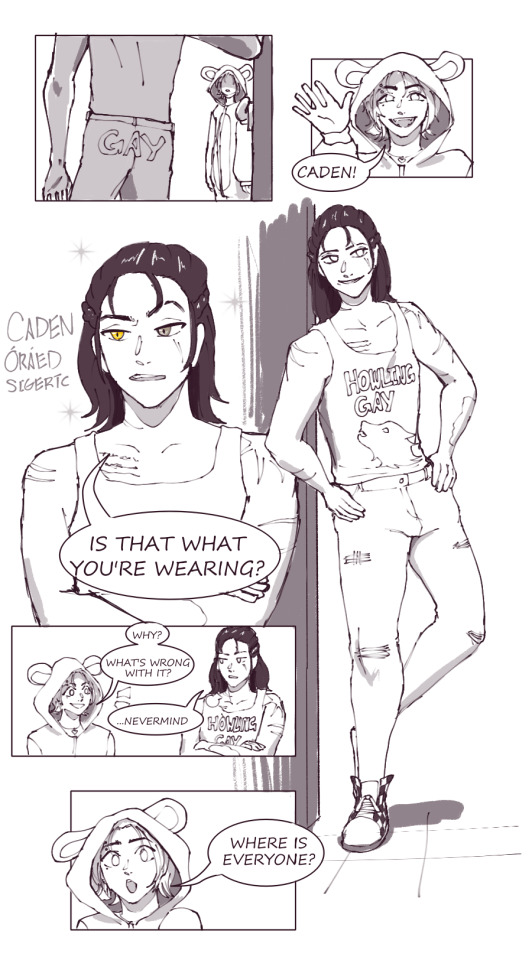
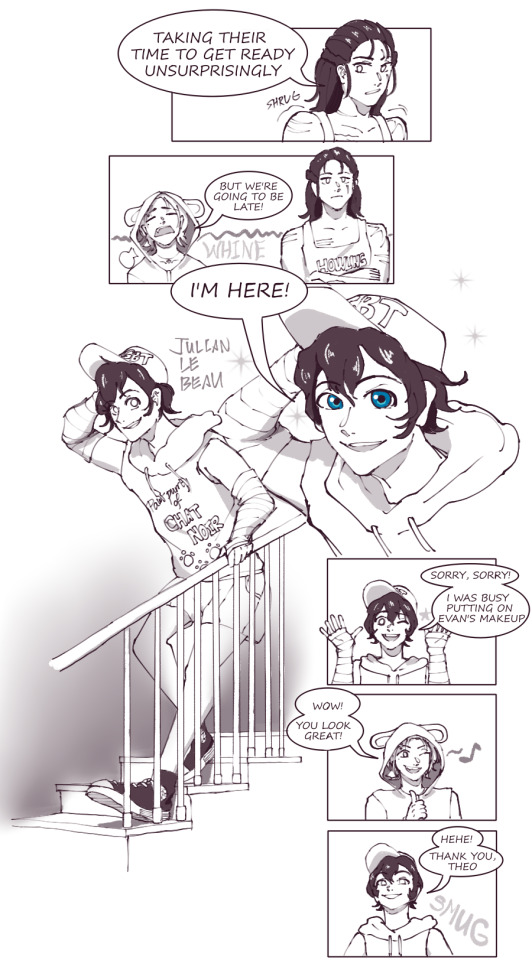
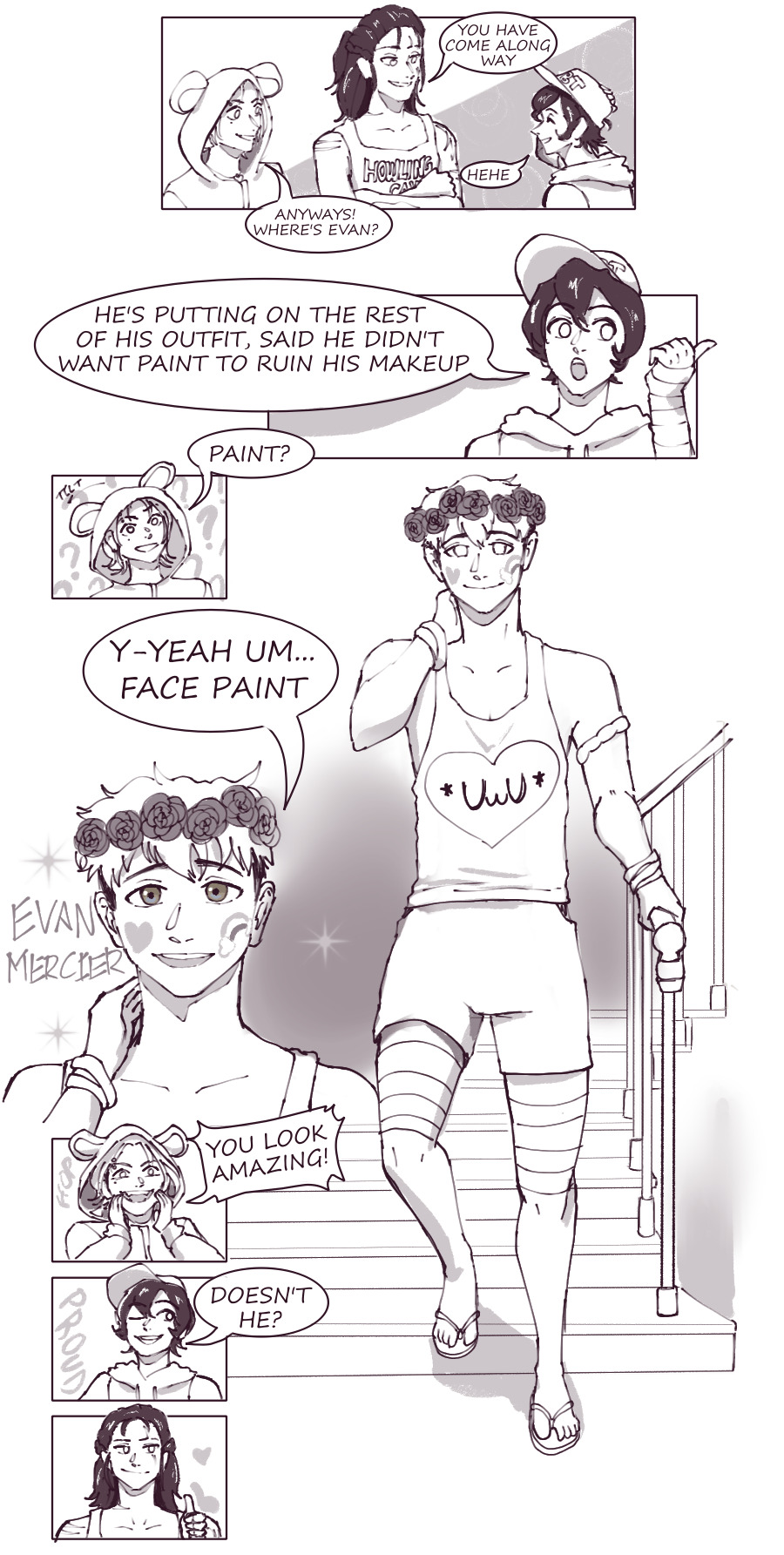
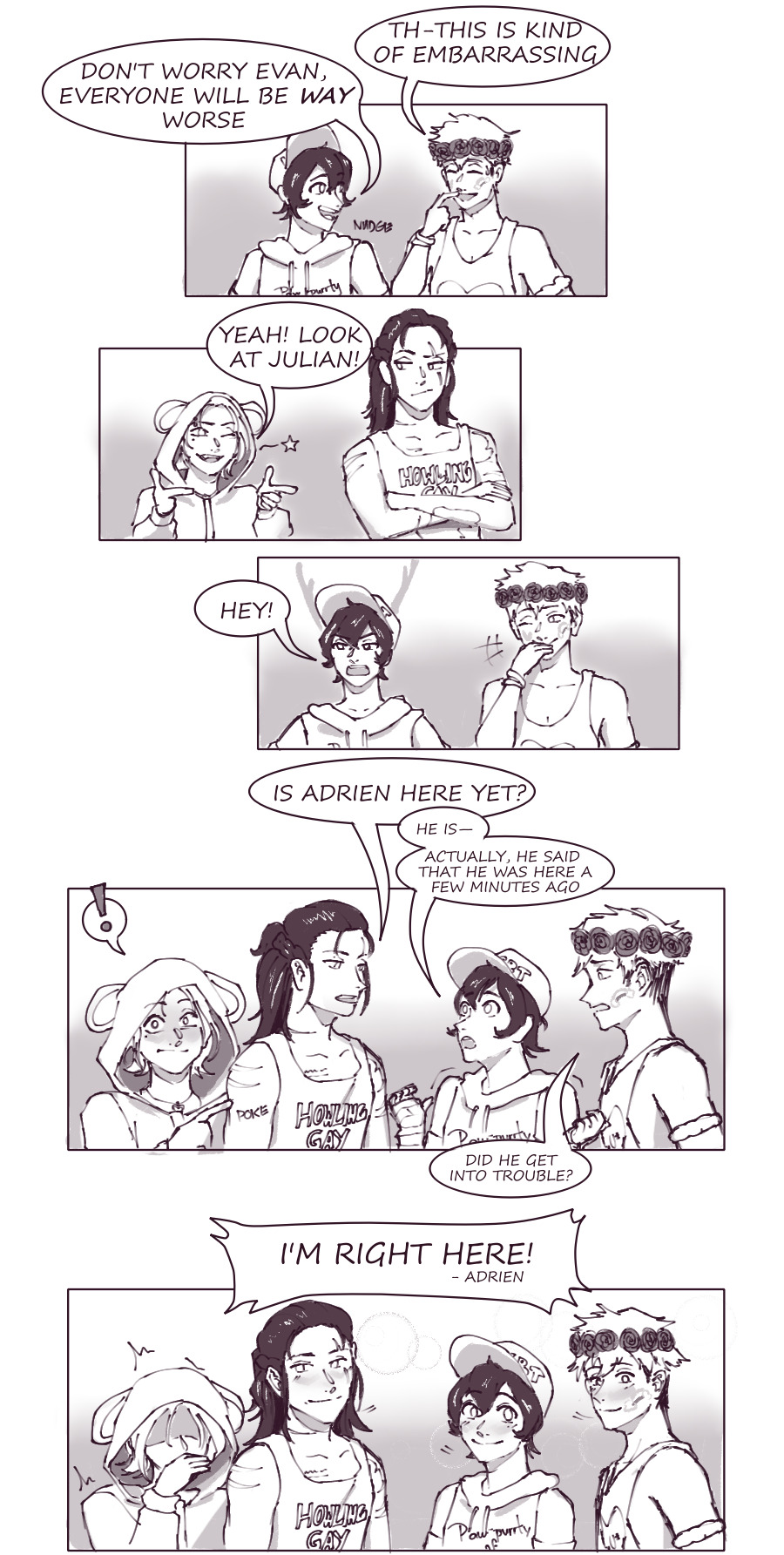
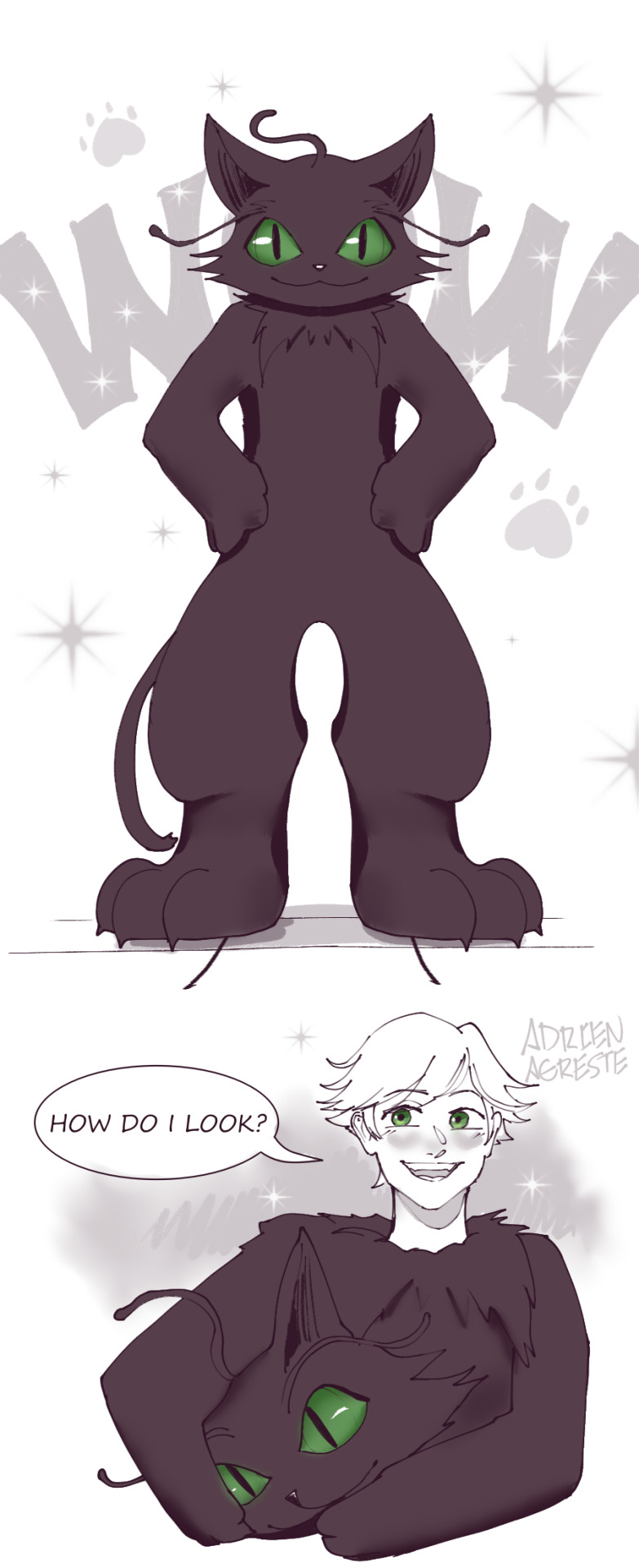
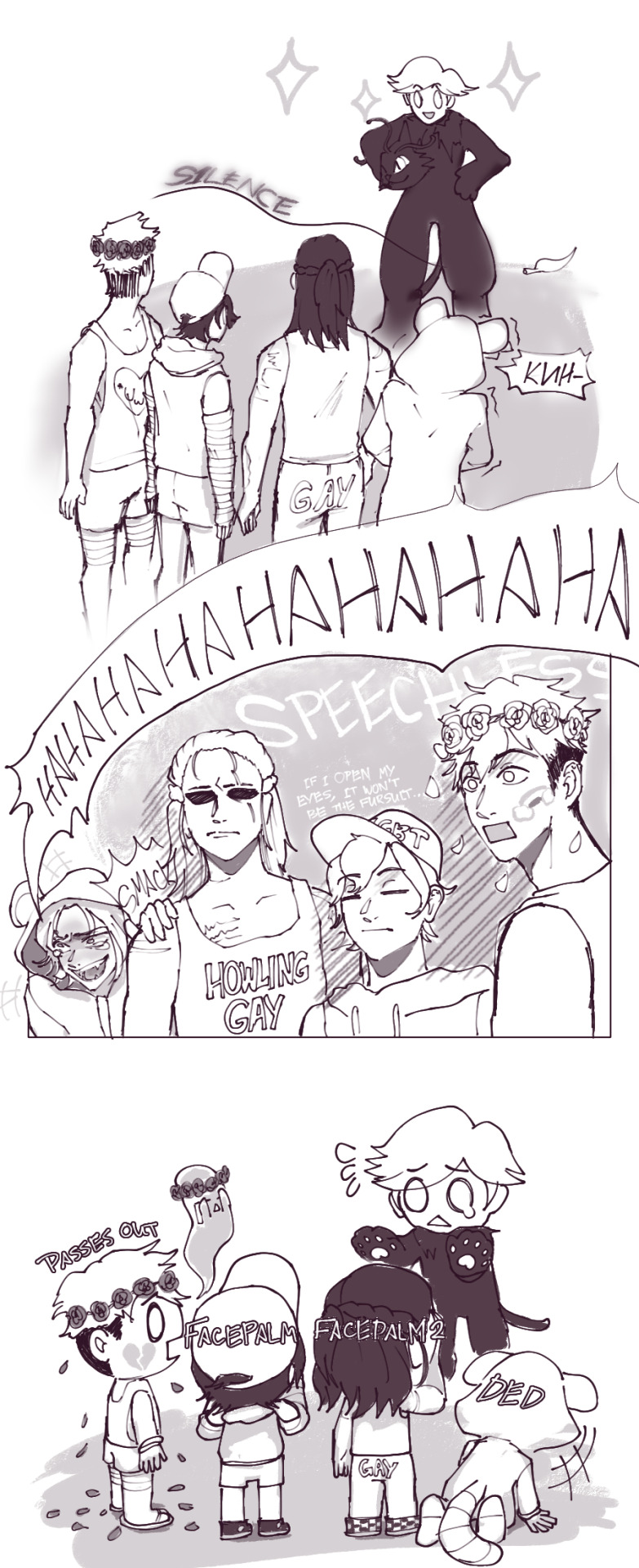


HAPPY PRIDE EVERYBODY!!!
Thank you to @lollipopmixclo9 for drawing the awesome comic, and @dopesharktree for drawing the full art at the end. On behalf of all Adrien x OMC authors out there, we love all of your support, and hope that you’ll be here for the many months to come! ^^
Thank you for reading!!!
#Miraculous Ladybug#FAON-ART#Miraculous Ladybug Pride#pride month#Miraculous Ladybug Fan-Art#Adrien Agreste#Adrien Agreste x OMC#evan mercier#Julian Le Beau#Caden Óráed Sigerīc#Theo Charron#OMCs for days!#Happy Pride Everybody!#Please give your support to the artists!
40 notes
·
View notes
Text
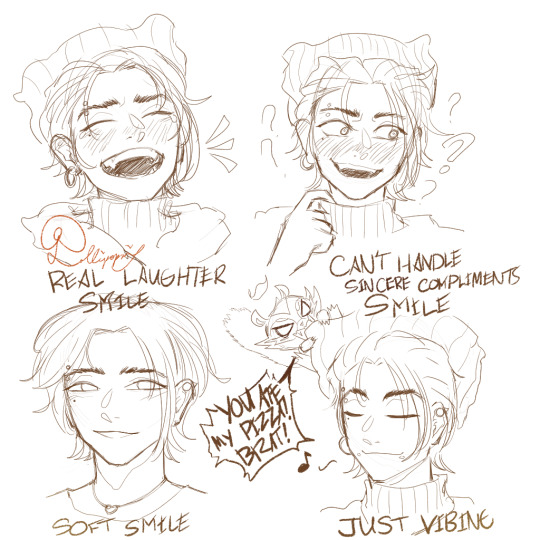


doodles because finals are coming and me want to destressss
Last picture original characters not mine but from @nervou5wr3ck's fanfic Seriously Doe, Mew Have Me Hooked!
#my art#doodles#animedrawing#i have this insane urge to draw feral expressions#miraculous oc#theo charron#Rôdeur des Rues#don't question the leg kabedon drawing#not me realizing theo chloe and sabrina have their foreheads exposed#they're baby eggs and even if chloé won't have a redemption in the show she is still an egg#utterly ridiculous bodyguard au#fanart of a fanfic#i'm quite fawn'd of you my deer#seriously doe mew have me hooked!#also poooooggggggg luca's karaoke stream pooooggggg#lmao caption what happened to Caleb and Julian to make Dasan scold them#nervou5wr3ck (scy114)#faon-art
40 notes
·
View notes
Text
Souvenir...
Instagram : emelineparentpics 🎥
Youtube : Emeline Parent Photographe 🎥
#france#nature#nord#art#hautsdefrance#hdf#photography#photographe#chevreuil#wildlife photography#wildlife#wild animals#roe deer#deer#faon#fawnart
286 notes
·
View notes
Photo
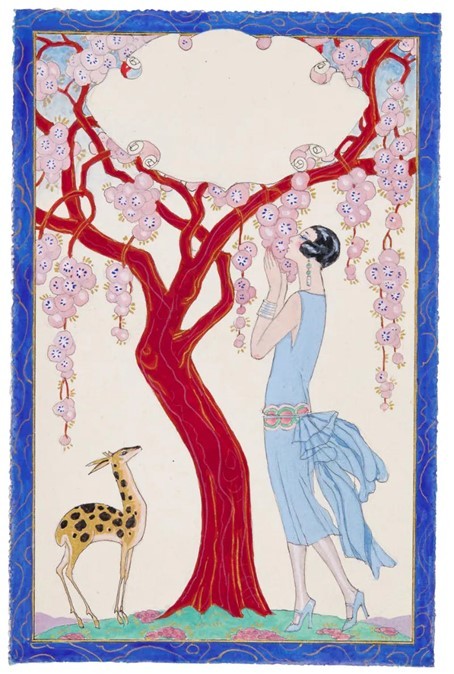
1920s George Barbier, Femme, Faon et Arbre Rouge. Foto: Sotheby's
5 notes
·
View notes
Text
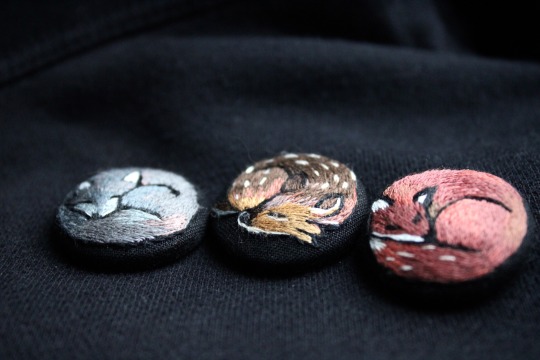


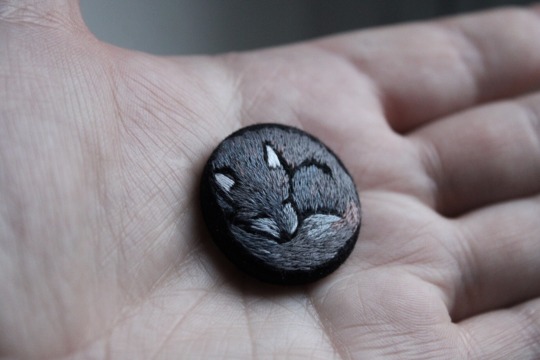


The three sleepers.
Embroidery, 2,8 cm ⌀, button/badge. Available on the shop in January.
#art#animal#modern embroidery#hand embroidery#embroidery#handcraft#craft#fawn#faon#loup#wolf#fox#renard#sleeping#sleeping fox#needle painting#badge#button#broderie
291 notes
·
View notes
Photo

L’apparence d’un faon dans le ton ocre, couleur issue de diverses argiles...
2 notes
·
View notes
Text

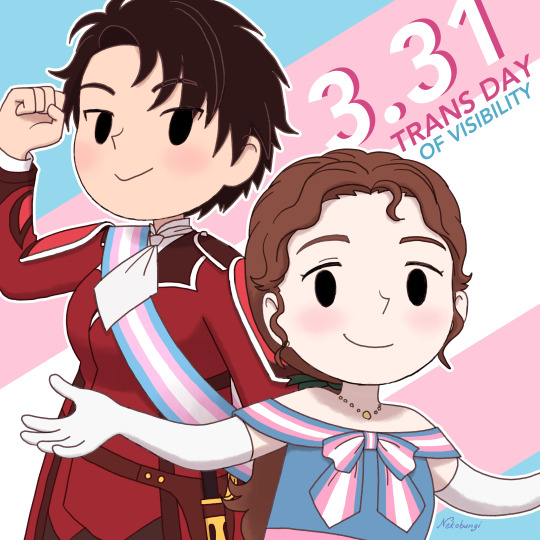
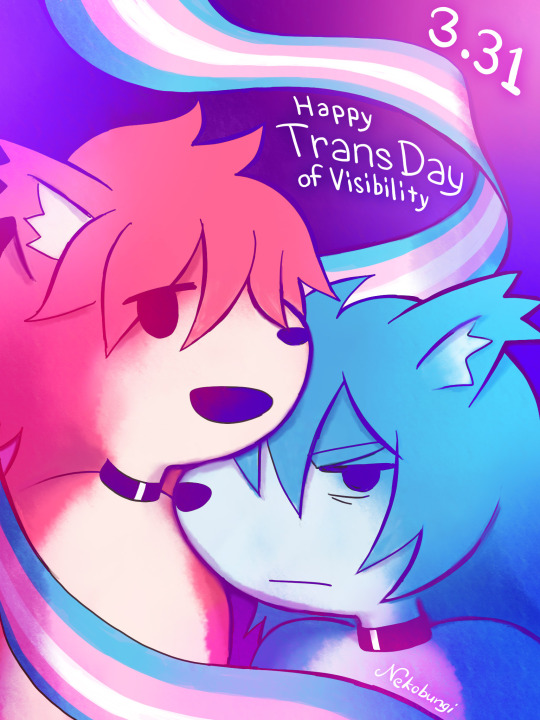
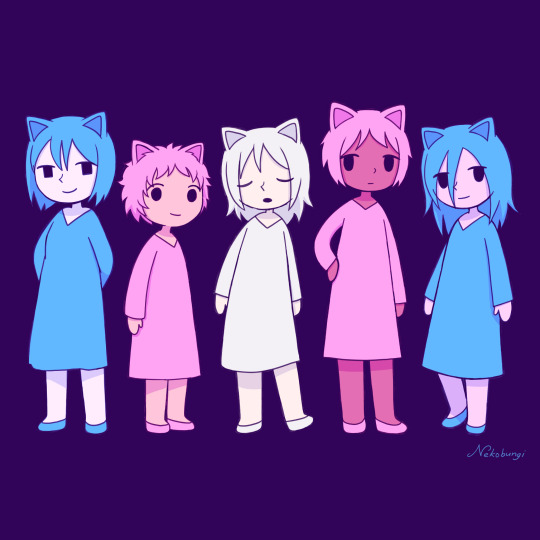
TDOV arts from 2019-2022
#oc art#my art#trans#transgender#trans pride#trans day of visibility#naomi#sandra#teru#alice#tetri#lepus#azami#faon
232 notes
·
View notes
Text

Inktober day 11: OC
Took the chance to age up my RadioApple fankids and redesign them a bit
#hazbin hotel#hazbin fanart#helluverse#hellaverse#hazbin art#demon#fanart#alastor#hazbin alastor#hazbin lucifer#lucifer#lucifer morningstar#fankids#fanchild#radioapple#radioapple fankid#radioapple fanchild#appleradio#Am and Fm#Astre and Faon#radioapple twins#duckiedeer#astre morningstar#Faon morningstar#hazbin fankid
20 notes
·
View notes
Photo

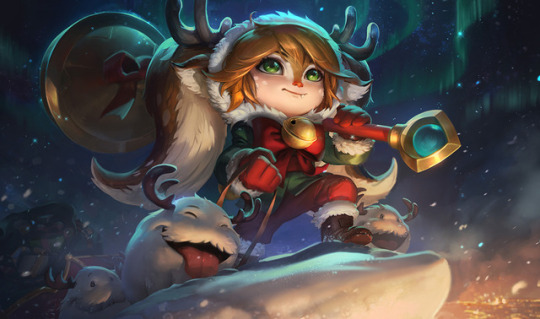
Ambitious Elf Jinx & Snow Faon Poppy Splash Arts !
Jinx : https://www.artstation.com/jemflores & https://www.artstation.com/jeango
Poppy : https://www.artstation.com/crutz & https://www.artstation.com/alexflores
#so pretty#poppy so pure#poppy#jinx#lol#league of legends#splash art#snow faon poppy#ambition elf jinx#christmas#jinx the loose cannon#zaun#yordle#demacia#bandle city#poppy keeper of the hammer#snowdown#lol skins#christmas skins
654 notes
·
View notes
Text
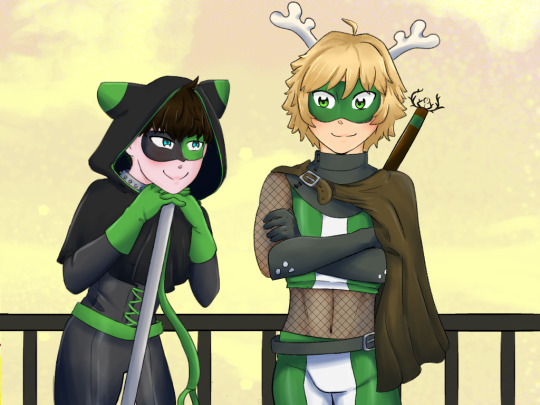
I can finally post this now x)
I had a lot of fun designing these outfits! I think they really suit their personalities a lot, hope you like them too ^^
Oh, and of course thank you @dopesharktree as always for drawing this work of art, love you bro! ^w^
#miraculous ladybug#miraculous ladybug fanfiction#miraculous ladybug oc#julian le beau#faon vert#Adrien Agreste#chat noir#Kwami Swap!#Julian as Chat#Adrien as Faon#FAON-ART
28 notes
·
View notes
Text

POV U'r Julian and there's a bad boy in ur room and Edgar Allan Poe's favorit birb 😂🙈(also my favorite but I love corvids in general tho)
Basically my visual of how Caleb Sanchez and Frigg looks like from Seriously Doe, Mew Have Me Hooked! by @nervou5wr3ck!
#my art#animedrawing#doodles#miraculous oc#ocs not mine#caleb sanchez#fanart#fanart of a fanfic#frigg#i'm quite fawn'd of you my deer#seriously doe mew have me hooked!#nervou5wr3ck (scy114)#i'm inhaling copium 😂🙈#idk if their eye colors are rightttt#and yes Frigg is judging u#i loooooOOOOOooooveeee piercingssss#faon-art
34 notes
·
View notes
Text
Petit faon 🥰🥰🥰🦌🦌🦌
Instagram : emelineparentpics
Youtube : Emeline Parent Photographe 🎥
#france#nature#nord#art#hautsdefrance#hdf#photography#photographe#wild animals#wildlife photography#wildlife#wildlife videos#naturfotografie#natural#faon#fawnart#forest#chevreuil#roe deer#deer
129 notes
·
View notes

